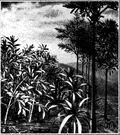and
Cordaites sp.); locality 1162 (GSC 9931--together with Calamites sp.; here Fig.
gigas, Sphenophyllum thonii) are very diversified in the first but absent in the red sediments; similarly the callipterids with small pinnules (Arnhardtia mouretii, Gracilopteris strigosa, Rhachiphyllum schenkii), but also Odontopteris subcrenulata,
Cordaites borassifolius and Poacordaites which were extending from the basal Autunian into the grey sediments of the Transition zone become absent in the red sediments.
Certain giant horsetails, of the genus Calamites, which reached heights of up to 33 ft (10 m) and which had huge stems, were abundant in that tall forest, together with treelike Cordaitaceae (
Cordaites), which had long leaves and a similar shape to that of the araucarias, and ferns (Sphenophyl-lum, etc.), perhaps the bestknown plants among the flora of that time.
The contact represents an angular unconformity in the subsurface (Waldron and Rygel 2005) and records a pronounced biostratigraphic break marked by the appearance of
Cordaites macroflora and the incoming of the cordaitalean prepollen Florinites (Calder 1998; Utting and Wagner 2005; Utting et al.
This ichnogenus which comprises several isp, was discovered in the "Lower
Cordaites" Formation (Carboniferous, USA).
Rudolph Florin on the evolution of the vegetative and reproductive structures of the
cordaites and early conifers.
polypodioides, Scolecopteris,
Cordaites lingulatus, Sphenophyllum costa, S.
Dawson, 'consists principally of the flattened bark of Sigillarioid and other trees, intermixed with leaves of Ferns and
Cordaites, and other herbaceous debris, and with fragments of decayed wood, constituting 'mineral charcoal', all these materials having manifestly alike grown and accumulated where we find them'."
The outer regions of stems (e.g., of arborescent lycopsids, calamites,
cordaites), to which root climbers may have been attached, are often not well preserved, and the climbers may have been separated from the stems during fossilization and/ or diagenesis.
Floated plant remains, most commonly
Cordaites leaves and Calamites stem and foliage remains, are found on the bedding planes of these ash fall deposits.
Unfragmented
Cordaites leaves, up to 22 cm in length, are common locally in red mudrock beds and channel sandstone bodies.
 Cordaites - tall Paleozoic trees superficially resembling modern screw pines; structurally intermediate in some ways between cycads and conifers
Cordaites - tall Paleozoic trees superficially resembling modern screw pines; structurally intermediate in some ways between cycads and conifers